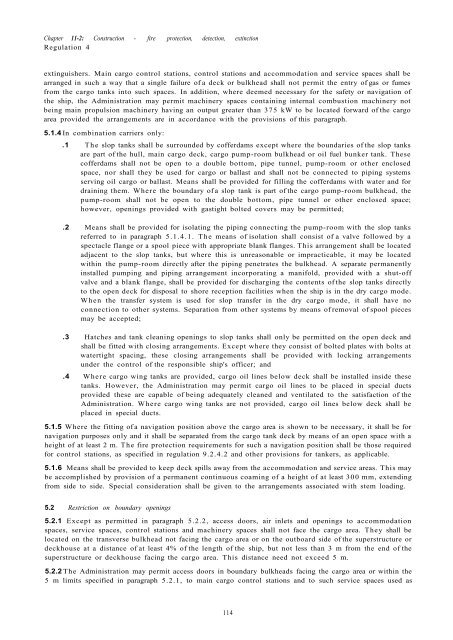Solas Consolidated Edition 2009.pdf
Solas Consolidated Edition 2009 for maritime
Solas Consolidated Edition 2009 for maritime
You also want an ePaper? Increase the reach of your titles
YUMPU automatically turns print PDFs into web optimized ePapers that Google loves.
Chapter 11-2: Construction - fire protection, detection, extinction<br />
Regulation 4<br />
extinguishers. Main cargo control stations, control stations and accommodation and service spaces shall be<br />
arranged in such a way that a single failure of a deck or bulkhead shall not permit the entry of gas or fumes<br />
from the cargo tanks into such spaces. In addition, where deemed necessary for the safety or navigation of<br />
the ship, the Administration may permit machinery spaces containing internal combustion machinery not<br />
being main propulsion machinery having an output greater than 375 kW to be located forward of the cargo<br />
area provided the arrangements are in accordance with the provisions of this paragraph.<br />
5.1.4 In combination carriers only:<br />
.1 The slop tanks shall be surrounded by cofferdams except where the boundaries of the slop tanks<br />
are part of the hull, main cargo deck, cargo pump-room bulkhead or oil fuel bunker tank. These<br />
cofferdams shall not be open to a double bottom, pipe tunnel, pump-room or other enclosed<br />
space, nor shall they be used for cargo or ballast and shall not be connected to piping systems<br />
serving oil cargo or ballast. Means shall be provided for filling the cofferdams with water and for<br />
draining them. Where the boundary of a slop tank is part of the cargo pump-room bulkhead, the<br />
pump-room shall not be open to the double bottom, pipe tunnel or other enclosed space;<br />
however, openings provided with gastight bolted covers may be permitted;<br />
.2 Means shall be provided for isolating the piping connecting the pump-room with the slop tanks<br />
referred to in paragraph 5.1.4.1. The means of isolation shall consist of a valve followed by a<br />
spectacle flange or a spool piece with appropriate blank flanges. This arrangement shall be located<br />
adjacent to the slop tanks, but where this is unreasonable or impracticable, it may be located<br />
within the pump-room directly after the piping penetrates the bulkhead. A separate permanently<br />
installed pumping and piping arrangement incorporating a manifold, provided with a shut-off<br />
valve and a blank flange, shall be provided for discharging the contents of the slop tanks directly<br />
to the open deck for disposal to shore reception facilities when the ship is in the dry cargo mode.<br />
When the transfer system is used for slop transfer in the dry cargo mode, it shall have no<br />
connection to other systems. Separation from other systems by means of removal of spool pieces<br />
may be accepted;<br />
.3 Hatches and tank cleaning openings to slop tanks shall only be permitted on the open deck and<br />
shall be fitted with closing arrangements. Except where they consist of bolted plates with bolts at<br />
watertight spacing, these closing arrangements shall be provided with locking arrangements<br />
under the control of the responsible ship's officer; and<br />
.4 Where cargo wing tanks are provided, cargo oil lines below deck shall be installed inside these<br />
tanks. However, the Administration may permit cargo oil lines to be placed in special ducts<br />
provided these are capable of being adequately cleaned and ventilated to the satisfaction of the<br />
Administration. Where cargo wing tanks are not provided, cargo oil lines below deck shall be<br />
placed in special ducts.<br />
5.1.5 Where the fitting of a navigation position above the cargo area is shown to be necessary, it shall be for<br />
navigation purposes only and it shall be separated from the cargo tank deck by means of an open space with a<br />
height of at least 2 m. The fire protection requirements for such a navigation position shall be those required<br />
for control stations, as specified in regulation 9.2.4.2 and other provisions for tankers, as applicable.<br />
5.1.6 Means shall be provided to keep deck spills away from the accommodation and service areas. This may<br />
be accomplished by provision of a permanent continuous coaming of a height of at least 300 mm, extending<br />
from side to side. Special consideration shall be given to the arrangements associated with stem loading.<br />
5.2 Restriction on boundary openings<br />
5.2.1 Except as permitted in paragraph 5.2.2, access doors, air inlets and openings to accommodation<br />
spaces, service spaces, control stations and machinery spaces shall not face the cargo area. They shall be<br />
located on the transverse bulkhead not facing the cargo area or on the outboard side of the superstructure or<br />
deckhouse at a distance of at least 4% of the length of the ship, but not less than 3 m from the end of the<br />
superstructure or deckhouse facing the cargo area. This distance need not exceed 5 m.<br />
5.2.2 The Administration may permit access doors in boundary bulkheads facing the cargo area or within the<br />
5 m limits specified in paragraph 5.2.1, to main cargo control stations and to such service spaces used as<br />
114


